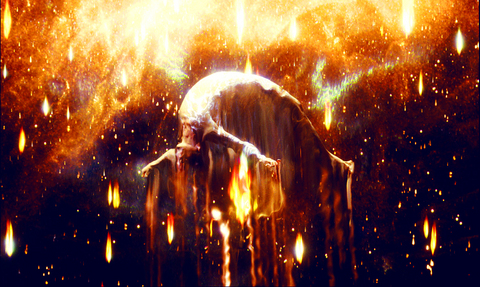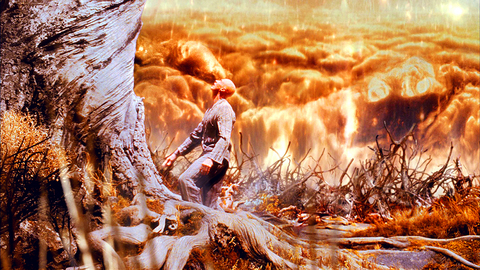In The Fountain, Darren Aronofsky's third feature (after Pi and Requiem for a Dream), Hugh Jackman and Rachel Weisz play star-crossed lovers in three different eras. Back in the 16th century, Weisz is Queen Isabel, a glowingly beautiful monarch menaced by the cruel intolerance of the Spanish Inquisition. (I know, I didn't expect it either.) Jackman is Tomas, a conquistador of sad countenance and unruly beard, hacking his way through the Central American jungles in search of the Tree of Life and in the service of his queen.
In the present, Jackman is a clean-shaven research scientist named Tom Creo, obsessively trying to develop a cure for the disease that threatens the life of his glowingly beautiful wife, Izzi (Weisz). Five hundred years in the future, Tom's head is completely bald, and he floats through the air. Weisz, if I'm not mistaken, has turned into a tree.
The three stories are not told in linear order, but in a circular, swirling pattern that suggests a mandala or a Mayan calendar. Circles also figure prominently in Aronofsky's visual scheme, and he seems to be trying, with a seriousness of purpose that few American filmmakers attempt, to subvert the essentially sequential nature of film. Like a story by Jorge Luis Borges, The Fountain dispenses with everyday assumptions about time, space and causality and tries to replace the prose of narrative cinema with a poetic language of rhyming images and visual metaphors.

PHOTOS COURTESY OF FOX
I wish I could say that it succeeded. At his best — which is to say as a maker of gorgeous, haunting compositions (exquisitely rendered in Matthew Libatique's cinematography) — Aronofsky can achieve an eloquence that suggests a blend of Andrei Tarkovsky (speaking of rhymes) and comic books. But his commitment to conveying meaning and emotion through painstakingly constructed images also gives the movie a static, claustrophobic atmosphere. (When Queen Isabel notes that "these are dark times," she seems to be commenting mainly on the relentless chiaroscuro of the lighting design.)
The director gives his main actors very little to do. Since their job is to embody a paradoxical romantic axiom — lovers may die, but love never does — they are trapped within a narrow range of emotions. Weisz's role is to glow and sigh, while Jackman registers various forms of anguish and desperation. The intensity of their feeling never breaks the surface, and the frame encases them like a vitrine. It's hard to sympathize with their hunger to overcome death, since neither one is credibly alive to begin with.
Entwined with their thousand-year melodrama is quite a bit of strenuous idea-mongering, having to do with the quest for eternal life and its consequences, and also with the tension between science and art. Tom Creo (the last name means "I believe" in Spanish) rages in the lab, bullying his subordinates and exasperating his supervisor (Ellen Burstyn) with his insistence on going after the secret of immortality rather than a mere cure for disease. Izzi, meanwhile, may have unlocked the secret herself, in a manuscript she has been working on (by hand, on old-fashioned folio pages) called The Fountain. "Finish it," she says to Tom.

She also tells him about Xibalba, the Mayan afterlife, a swirling vortex where all distinctions of present and past seem to vanish. Xibalba, which is also the name of a distant nebula in the movie, is connected to that tree, which is, according to the movie's dream logic, both a metaphor and an actual organism. (It is also, a bit misleadingly, the source of the film's title: fountain of youth, tree of life — same thing, really). It is where superstition and science meet, and where the truth of ancient religion is affirmed by the methods of modern science.
I think so, at any rate. To his credit, Aronofsky does not explain too much, and The Fountain leaves a tantalizing sense of puzzlement in its wake. Parsing its logic and arguing about its premises will be among the main activities of the small, devoted cult of admirers that is likely to gather around this movie, protecting it from the derision of the uninitiated. The problem, though, is that its techniques run too far beyond its ideas, which are blurry and banal, rather than mysterious and resonant. The Fountain is something to see, but it is also much less, finally, than meets the eye.


One of the biggest sore spots in Taiwan’s historical friendship with the US came in 1979 when US president Jimmy Carter broke off formal diplomatic relations with Taiwan’s Republic of China (ROC) government so that the US could establish relations with the People’s Republic of China (PRC). Taiwan’s derecognition came purely at China’s insistence, and the US took the deal. Retired American diplomat John Tkacik, who for almost decade surrounding that schism, from 1974 to 1982, worked in embassies in Taipei and Beijing and at the Taiwan Desk in Washington DC, recently argued in the Taipei Times that “President Carter’s derecognition

This year will go down in the history books. Taiwan faces enormous turmoil and uncertainty in the coming months. Which political parties are in a good position to handle big changes? All of the main parties are beset with challenges. Taking stock, this column examined the Taiwan People’s Party (TPP) (“Huang Kuo-chang’s choking the life out of the TPP,” May 28, page 12), the Democratic Progressive Party (DPP) (“Challenges amid choppy waters for the DPP,” June 14, page 12) and the Chinese Nationalist Party (KMT) (“KMT struggles to seize opportunities as ‘interesting times’ loom,” June 20, page 11). Times like these can

June 23 to June 29 After capturing the walled city of Hsinchu on June 22, 1895, the Japanese hoped to quickly push south and seize control of Taiwan’s entire west coast — but their advance was stalled for more than a month. Not only did local Hakka fighters continue to cause them headaches, resistance forces even attempted to retake the city three times. “We had planned to occupy Anping (Tainan) and Takao (Kaohsiung) as soon as possible, but ever since we took Hsinchu, nearby bandits proclaiming to be ‘righteous people’ (義民) have been destroying train tracks and electrical cables, and gathering in villages

Dr. Y. Tony Yang, Associate Dean of Health Policy and Population Science at George Washington University, argued last week in a piece for the Taipei Times about former president Ma Ying-jeou (馬英九) leading a student delegation to the People’s Republic of China (PRC) that, “The real question is not whether Ma’s visit helps or hurts Taiwan — it is why Taiwan lacks a sophisticated, multi-track approach to one of the most complex geopolitical relationships in the world” (“Ma’s Visit, DPP’s Blind Spot,” June 18, page 8). Yang contends that the Democratic Progressive Party (DPP) has a blind spot: “By treating any